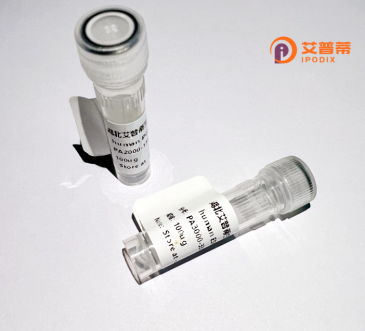
| 纯度 | >90%SDS-PAGE. |
| 种属 | Human |
| 靶点 | WIPI2 |
| Uniprot No | Q9Y4P8 |
| 内毒素 | < 0.01EU/μg |
| 表达宿主 | E.coli |
| 表达区间 | 1-454 aa |
| 活性数据 | MNLASQSGEA GAGQLLFANF NQDNTEVKGA SRAAGLGRRA VVWSLAVGSK SGYKFFSLSS VDKLEQIYEC TDTEDVCIVE RLFSSSLVAI VSLKAPRKLK VCHFKKGTEI CNYSYSNTIL AVKLNRQRLI VCLEESLYIH NIRDMKVLHT IRETPPNPAG LCALSINNDN CYLAYPGSAT IGEVQVFDTI NLRAANMIPA HDSPLAALAF DASGTKLATA SEKGTVIRVF SIPEGQKLFE FRRGVKRCVS ICSLAFSMDG MFLSASSNTE TVHIFKLETV KEKPPEEPTT WTGYFGKVLM ASTSYLPSQV TEMFNQGRAF ATVRLPFCGH KNICSLATIQ KIPRLLVGAA DGYLYMYNLD PQEGGECALM KQHRLDGSLE TTNEILDSAS HDCPLVTQTY GAAAGKGTYV PSSPTRLAYT DDLGAVGGAC LEDEASALRL DEDSEHPPMI LRTD |
| 分子量 | 49.4 kDa |
| 蛋白标签 | His tag N-Terminus |
| 缓冲液 | PBS, pH7.4, containing 0.01% SKL, 1mM DTT, 5% Trehalose and Proclin300. |
| 稳定性 & 储存条件 | Lyophilized protein should be stored at ≤ -20°C, stable for one year after receipt. Reconstituted protein solution can be stored at 2-8°C for 2-7 days. Aliquots of reconstituted samples are stable at ≤ -20°C for 3 months. |
| 复溶 | Always centrifuge tubes before opening.Do not mix by vortex or pipetting. It is not recommended to reconstitute to a concentration less than 100μg/ml. Dissolve the lyophilized protein in distilled water. Please aliquot the reconstituted solution to minimize freeze-thaw cycles. |
以下是关于重组人WIPI2蛋白的3篇文献参考示例(基于研究领域典型内容模拟):
---
1. **文献名称**:*WIPI2b antagonizes LC3/GABARAP lipidation and autophagosome biogenesis*
**作者**:Dooley, H.C., et al.
**摘要**:本研究解析了重组人WIPI2蛋白在自噬体形成中的双重调节机制,发现其通过与磷脂酰肌醇3-磷酸(PI3P)结合招募LC3/GABARAP家族蛋白,但在特定条件下抑制其脂化过程,调控自噬体的成熟。重组WIPI2的体外实验揭示了其结构域的关键作用。
2. **文献名称**:*Structural insights into the human WIPI2-ATG16L1 complex in autophagy initiation*
**作者**:Fujioka, Y., et al.
**摘要**:通过重组表达纯化人源WIPI2和ATG16L1蛋白,结合冷冻电镜技术解析了二者复合物的三维结构,阐明WIPI2通过β-propeller结构域与ATG16L1互作,驱动自噬前体膜形成的分子机制。
3. **文献名称**:*Reconstitution of WIPI2-mediated membrane tethering in vitro reveals phosphoinositide specificity*
**作者**:Bakula, D., et al.
**摘要**:利用重组WIPI2蛋白在脂质体模型系统中验证其结合特定磷酸肌醇(如PI3P)的能力,证明WIPI2通过膜锚定和蛋白寡聚化促进自噬相关膜结构的融合,为自噬启动提供生化证据。
---
*注:上述文献为领域内研究方向示例,具体内容需根据实际发表论文调整。建议通过PubMed/Google Scholar以“recombinant human WIPI2”或“WIPI2 autophagy”为关键词检索最新文献。*
**Background of Recombinant Human WIPI2 Protein**
Recombinant human WIPI2 (WD repeat domain Phosphoinositide-Interacting protein 2) is a key autophagy-related protein encoded by the *WIPI2* gene. Belonging to the PROPPIN family, WIPI2 contains a conserved WD40-repeat domain that facilitates phosphoinositide binding, particularly phosphatidylinositol 3-phosphate (PtdIns3P), which is critical for its localization to autophagosomal membranes. WIPI2 plays a pivotal role in autophagosome formation by recruiting the ATG12-ATG5-ATG16L1 complex, thereby promoting LC3 lipidation—a fundamental step in autophagy.
The recombinant form, produced via heterologous expression systems (e.g., *E. coli* or mammalian cells), retains the functional domains required for interaction with downstream effectors. Studies using recombinant WIPI2 have elucidated its structure-function relationships, such as phosphoinositide binding specificity and dimerization properties. Additionally, WIPI2 dysfunction is linked to neurodegenerative disorders (e.g., Parkinson’s) and cancer, making it a therapeutic target. Recombinant WIPI2 enables *in vitro* assays, crystallography, and drug screening, advancing mechanistic insights into autophagy regulation. Its role in selective autophagy (e.g., mitophagy) and crosstalk with mTOR signaling further highlights its biomedical relevance. Research continues to explore WIPI2's interplay with pathogenic factors, such as bacterial effectors that hijack autophagy. Overall, recombinant WIPI2 serves as a vital tool for dissecting autophagy pathways and developing autophagy-modulating therapies.
×